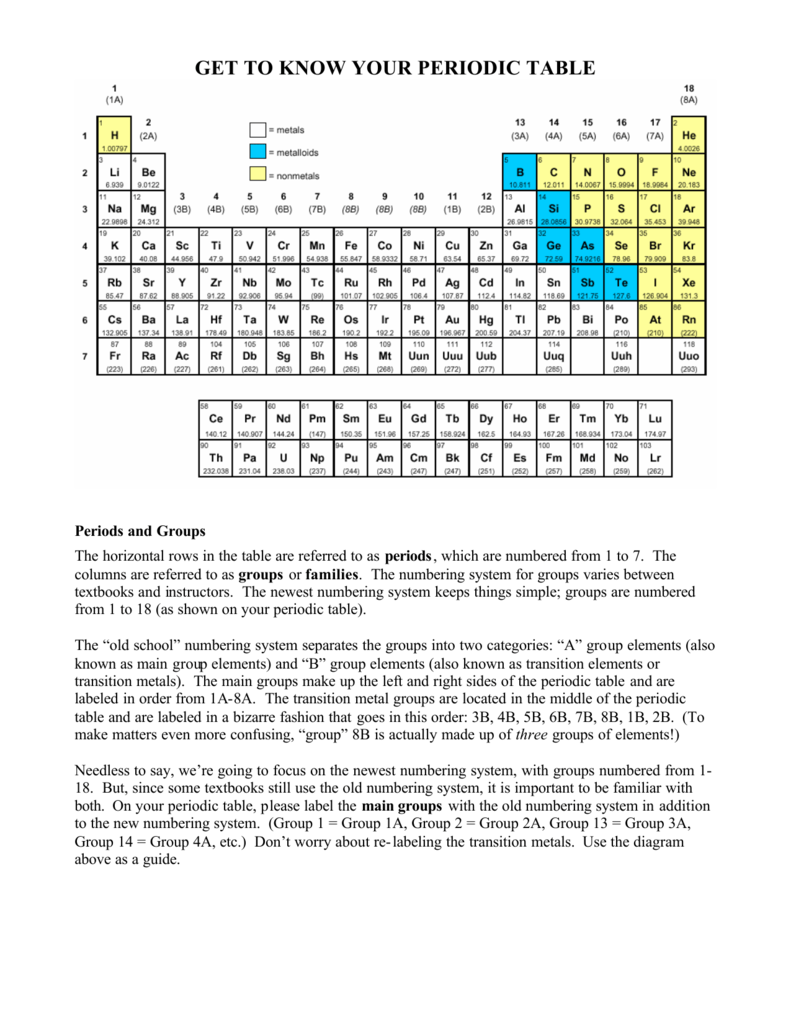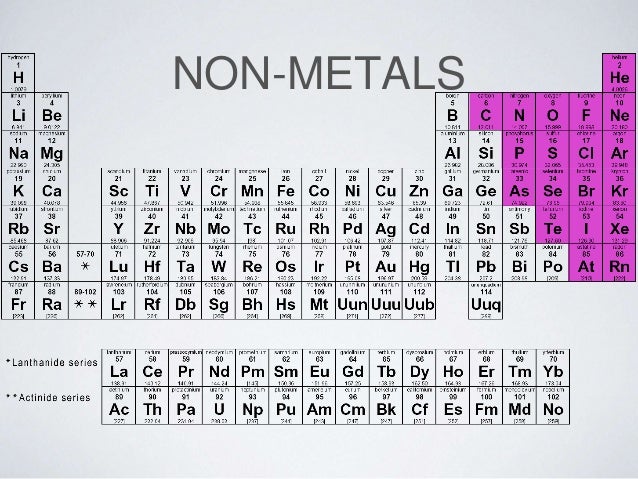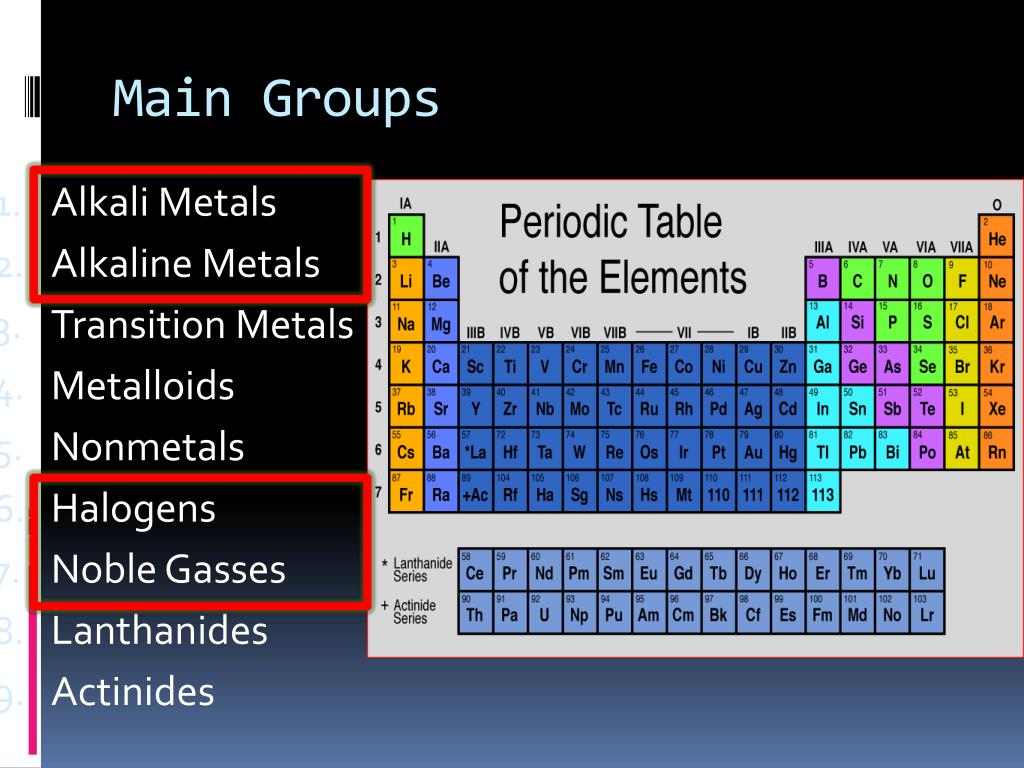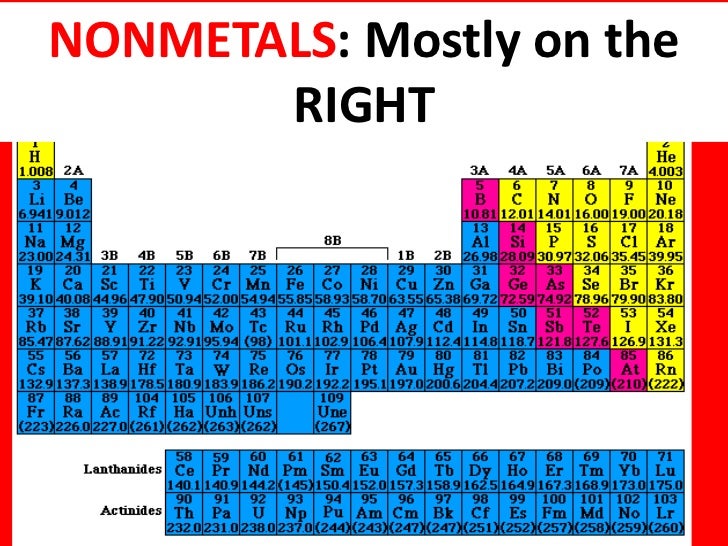38 periodic table with metal and nonmetal labels
Periodic table metals metalloids and nonmetals 10000+ results for 'periodic table metals metalloids and nonmetals' 6.6A Metals, Nonmetals and Metalloids Group sort by Jmonarez G6 G8 Metals, Nonmetals, Metalloids Maze chase by Kelsiedreiling2 G6 Science Metals, Metalloids and Nonmetals Gameshow quiz by Ktsimms31 G5 Science Metals Nonmetals and Metalloids Match up by Kmarchetti Metalloid - Wikipedia Periodic table extract showing groups 1–2 and 12–18, and a dividing line between metals and nonmetals. Percentages are median appearance frequencies in the list of metalloid lists. Sporadically recognised elements show that the metalloid net is sometimes cast very widely; although they do not appear in the list of metalloid lists, isolated references to their designation …
Periodic table Groups Explained !! (With 1-18 Group Names) There are total 18 different groups in Periodic table. Group 1: Alkali metals group (hydrogen not included) Group 2: Alkaline earth metals group. Group 3-12: Transition and Inner transition metals group. Group 13: Boron group. Group 14: Carbon group. Group 15: Nitrogen group.

Periodic table with metal and nonmetal labels
The Periodic Table Of Metals And Nonmetals | Science Trends Non-Metals In The Periodic Table Non-metals can be easily located on the Periodic Table because they are to the right of the line that looks like a stepping ladder. The only exception to this is atomic number 1, Hydrogen (H), which has a different location on the table. Non-metals are characterized by having the exact opposite properties of metals. Groups and Periods of the Periodic Table --------------------Metals ... Metals (left side of a period) generally have a lower electron affinity than nonmetals (right side of a period), with the exception of the noble gases. According to their shared physical and chemical properties, the elements can be classified into the major categories of metals, metalloids and nonmetals. Metals Most elements are metals. Periodic Table of the Elements - Metals The elements are divided into two main types, metals and nonmetals, based on their properties. About 75% of the elements are classified as metals. The name metal comes from the Greek word "m tallon" meaning "mine, quarry, metal". Properties of metals: Mostly solids Hard, shiny, malleable meaning flexible
Periodic table with metal and nonmetal labels. Periodic Table: Metals, Non-metals, and Metalloids - Quizlet Terms in this set (40) Metalloid. the set of elements that separate the metals from the nonmetals on the periodic table and that possess properties of both metals and nonmetals. Period. Group. Periodic trend (This is why the table is called periodic) These groups are entirely metals. This group is entirely inert (non-reactive gases) Metal and non-metal oxides - The periodic table - BBC Bitesize Metals in the periodic table Metals are found on the left and in the middle of the periodic table. A line of steps underneath boron (B) can be drawn to divide the table into metals and non-metals.... Periodic table labeled with Metals Nonmetals and Metalloids Periodic table labeled with Metalloids Above picture shows you the labeled Metalloids on the Periodic table. They are found between the metals and nonmetals. Elements which have the metallic properties as well as nonmetallic properties are classified as Metalloids. Because of this reason, they are also known as semimetals. Periodic Table Printable - Free Printable Periodic Table 2022 Periodic Table Metals And Nonmetals With Names - There are various teams of precious metals within the Periodic Kitchen table, and this information will check out the key categories of these elements. In addition, we'll deal with a few of the more technical metal alloys, such as silver and gold. Also you can understand move … Read more
Metals and Non Metals of the Periodic Table From Group 13 to 16 these are a mixture of metals, non-metals, and semimetals. For example Group 15 contains the non-metals Nitrogen and Phosphorus, the semi-metal Arsenic and the metals Antimony and Bismuth. These non metals have very different properties to metals, they do not tend to barde shiny and wont conduct heat or electricity well. Labeled Periodic Table of Elements with Name [PDF & PNG] There are 18 groups in the periodic table, which consists of metal and nonmetal. Protons in the tables are positively charged particles. Neutrons are the neutrally negative charge, and electrons are the negative charge particles. It also shows the formation of a bond from one element to the other. PDF Labelled Periodic Table with Charges Nonmetal - Wikipedia In periodic table terms, an analogy can be drawn between the noble gases and noble metals such as platinum and gold, with the latter being similarly reluctant to enter into chemical combination. As a further example, xenon, in the +8 oxidation state, forms a pale yellow explosive oxide, XeO 4 , while osmium , another noble metal, forms a yellow strongly oxidizing oxide, OsO 4 . On Periodic Table Label Alkaline Earth Metals Halogens 1 number of the routine kitchen table that is not going to should be in the steel family is the halogens. These extremely reactive no-metal components are found in class 17 and make up the 17th column. They can be made up of fluorine, chlorine and bromine and iodine, so that as of this composing, astatine.
Periodic Table of Elements: Los Alamos National Laboratory Metalloid (or "semi-metal" or "poor metal"). The metalloids are B, Si, Ge, As, Sb, Te, and Po. They sometimes behave as semiconductors (B, Si, Ge) rather than as conductors. Lanthanides. The lanthanides comprise elements 57 (lanthanum, hence the name of the set) through 71. They are grouped together because they have similar chemical properties. 2018 INTERNATIONAL RESIDENTIAL CODE (IRC) | ICC DIGITAL … N1101.1 Scope.. This chapter regulates the energy efficiency for the design and construction of buildings regulated by this code. Note: The text of the following Sections N1101.2 through N1111 parallels the text of the 2018 edition of the International Energy Conservation Code—Residential Provisions (IECC-R). The section numbers appearing in parenthesis after each section number … Properties of Periodic Table of Element Groups - ThoughtCo This is what is meant by periodicity or periodic table trends . There are multiple ways of grouping the elements, but they are commonly divided into metals, semimetals (metalloids), and nonmetals. You'll find more specific groups, like transition metals, rare earths, alkali metals, alkaline earth, halogens, and noble gasses. Labeled Periodic Table | Science Trends Semimetals, or metalloids, have properties which are in between metals and nonmetals. These properties are: Can be either dull or shiny Often effective semiconductors Can lose or gain electrons in chemical reactions Have several different forms Nonmetals are elements that have properties which are quite distinct from metals.
eCFR :: 29 CFR 1910.1450 -- Occupational exposure to hazardous ... The in-page Table of Contents is available only when multiple sections are being viewed. ... or gas); self reactive; pyrophoric (gas, liquid or solid); self-heating; organic peroxide; corrosive to metal; gas under pressure; in contact with water emits flammable gas; or combustible dust. The criteria for determining whether a chemical is classified as a physical hazard are in appendix B …
Labeled Periodic Table of Elements with Names - Science Struck Non-Metals: Hydrogen, Carbon, Nitrogen, Oxygen, Phosphorus, Sulfur and Selenium are seven non-metals located in the 14th, 15th and 16th group of the periodic table. These elements are very brittle and do not easily conduct electricity. Noble Gases: Noble gases are located in 18th group of the periodic table. Helium, Neon, Argon, Krypton, Xenon ...
The Periodic Table: Metals, Nonmetals, and Metalloids Using the periodic table, you can classify the elements in many ways.One useful way is by metals, nonmetals, and metalloids. The periodic table is organized in families and periods. Metals In the periodic table, you can see a stair-stepped line starting at Boron (B), atomic number 5, and going all the way down to Polonium (Po), atomic number 84.
1910.1450 App A - Occupational Safety and Health Administration The CSB issued a case study on an explosion at Texas Tech University in Lubbock, Texas, which severely injured a graduate student handling a high-energy metal compound. Since 2001, the CSB has gathered preliminary information on 120 different university laboratory incidents that resulted in 87 evacuations, 96 injuries, and three deaths.
O Level Chemistry - Periodic Table Mini Series (Part III) - O Level Chemistry & IP Chemistry ...
[PDF] ASHRAE handbook fundamental - Free Download PDF 15.08.2017 · Table 3 or Equation (5) or (6) Equation (24) Equation (22) Equation (23) Equation (12) Equation (28) Equation (32) Table 3 with Equation (38), (39), or (40) Equation (23) and (35) or (37) with Table 3 or with Equation (5) or (6) Sat. press. for temp. t Using pws (t) Using Ws The dry-bulb temperature ranges covered by the charts are Charts 1, 4, 5 Chart 2 Chart 3 Normal …
3 Minerals – An Introduction to Geology The term “minerals” as used in nutrition labels and pharmaceutical products is not the same as a mineral in a geological sense. ... 3.1.2 Periodic Table of the Elements. Matter is composed of elements which are atoms that have a specific number of protons in the nucleus. This number of protons is called the Atomic Number for the element. For example, an oxygen atom has 8 …
Metals, Non-Metals and Metalloids - GeeksforGeeks Metals, non-metals, and metalloids are the most common elements. Compounds, on the other hand, are pure entities formed by the chemical combination of two or more elements in a predetermined ratio. Chemical procedures, on the other hand, can break down these compounds into individual elements. e.g. gold, copper, oxygen, chlorine, diamond, etc.
Metals, Nonmetals, and Metalloids on the Periodic Table A description and practice of finding metals, nonmetals, and metalloids on the Periodic Table.In general metals are found on the left-hand side of the period...
Blocks of the Periodic Table: s-block, p-block, d-block, f-block Also, read about Trends in Periodic Table, here. Non - Metals Non-metals are located at the top right-hand side of the Periodic Table. In a horizontal row, the property of elements changes from metallic on the left to non-metallic on the right. Non-metals are usually solids or gases at room temperature with low melting and boiling points.
Elements and The Periodic Table | CHEM 1305 Introductory Chemistry ... Using the periodic table, classify each of the following elements as a metal or a nonmetal, and then further classify each as a main-group (representative) element, transition metal, or inner transition metal: cobalt europium iodine indium lithium oxygen cadmium terbium rhenium Show Answer Identifying Elements
The Periodic Table | General Chemistry - Lumen Learning Groups are labeled at the top of each column. In the United States, the labels traditionally were numerals with capital letters. However, IUPAC recommends that the numbers 1 through 18 be used, and these labels are more common. ... Metal or Nonmetal? Using the periodic table, classify each of the following elements as a metal or a nonmetal, and ...
Periodic Table of Elements - PubChem Such was the case when IUPAC recently reviewed elements 113, 115, 117 and 118, and decided to give them official names and symbols (goodbye, ununseptium and hello, tennessine!). Atomic weights found within a periodic table one might think are constant. The truth is that atomic weights have changed as a function of time.
Build an Atom - Atoms | Atomic Structure | Isotope Symbols - PhET Build an atom out of protons, neutrons, and electrons, and see how the element, charge, and mass change. Then play a game to test your ideas!
Generative design of stable semiconductor materials using deep … Aug 04, 2022 · Table 2 The classification report of the test set for the nonmetal/metal classifiers. Full size table As seen in Table 2 , the RFC model exhibits a slight improvement over the DNN model.
Metals and non-metals in the periodic table - PubMed A link between that theory and the work of Sir Nevill Mott on the metal-non-metal transition is also highlighted. The application of the 'simple', but highly effective Goldhammer-Herzfeld and Mott criteria, reveal when a chemical element of the periodic table will behave as a metal, and when it will behave as a non-metal.
Metals and non-metals in the periodic table - The periodic table - AQA ... Metals are on the left of the periodic table, and non-metals are on the right. Atomic structure and the periodic table Elements in group 1 and group 2 are metals. Atoms of group 1 elements have one...
List of Metals - Science Notes and Projects Location of Metals on the Periodic Table. Over 75% of the elements are metals, so they fill most of the periodic table. Metals are on the left side of the table. The two rows of elements below the main body of the table (the lanthanides and actinides) are metals. Uses of Metals. Metals find use in every aspect of life. Here is a list of some of ...
Metals on the Periodic Table: Definition & Reactivity Learn about the groupings of metals and nonmetals on the periodic table, features in metallic bonding and reactivity, and their formation of ionic compounds. Updated: 10/13/2021 Create an account

:max_bytes(150000):strip_icc()/nonmetals-56a12d975f9b58b7d0bccfd3.png)











Post a Comment for "38 periodic table with metal and nonmetal labels"